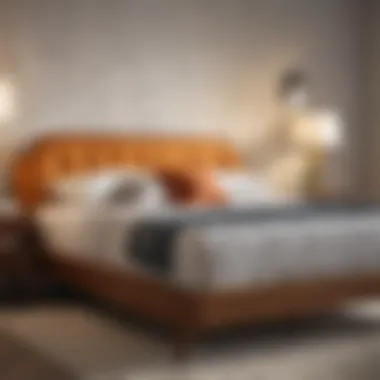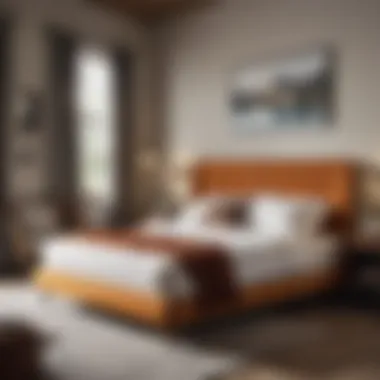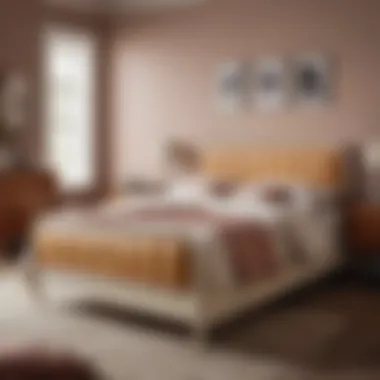The Allure of Retro Beds: Style and Comfort Combined


Intro
As homeowners, renters, designers, and DIY enthusiasts increasingly look for ways to express their identity through home decor, retro beds have emerged as more than just a place to lay one’s head. These beds, steeped in nostalgia, combine character with functionality, allowing for a unique blend of style and comfort that appeals to a diverse audience. This article embarks on a journey through the history, design variations, and enduring relevance of retro beds, revealing how these pieces not only enhance aesthetics but also cater to practical needs in contemporary interiors.
From the bold lines of mid-century modern to the intricate patterns of vintage designs, retro beds embody an array of styles that have shaped the way we think about personal spaces. Today, as sustainable living becomes a priority, many are rediscovering these timeless pieces, focusing on their potential to harmonize with modern decor while making eco-friendly choices.
Pull up a chair and get comfy as we dive deeper into this eclectic world of retro beds—where every headboard tells a story and every frame has a past.
Preface to Retro Beds
The world of design is a fascinating tapestry woven from various threads of history, culture, and personal expression. Among these threads, retro beds have captured the imagination of homeowners and interior designers alike. Why delve into this topic? Because retro beds are more than just furniture; they tell stories of eras gone by and reflect the aesthetic values of their time. Whether you’re an avid collector, a casual renter, or a designer with a keen eye for aesthetics, understanding retro beds becomes essential in creating spaces that resonate with character and charm.
Defining Retro Furniture Styles
Retro furniture styles are not merely a replication of past designs; they embody an ethos of creativity and rebellion against the ordinary. Generally, the term ‘retro’ refers to styles that evoke designs from the mid-20th century through the late 20th century, particularly the 1950s to the 1980s. However, it can feel a bit like trying to catch smoke with your bare hands, as retro styles can vary widely depending on geographic and cultural contexts.
In essence, defining retro can hinge on several key characteristics:
- Color Palette: Bold, vibrant colors often dominate retro beds, making a statement that whispers tales of cheerfulness and warmth. Think avocado green, mustard yellow, and flame orange.
- Material Choices: Retro beds often use materials like molded plastic, chrome, and particle board, diverging from the traditional wooden frames. This mixed media approach opens up many avenues for creative expression.
- Design Motifs: Patterns abound in retro design, from geometric shapes to organic motifs. This kaleidoscope of patterns can transform a bedroom into a visual delight.
With these characteristics in mind, embracing retro styles offers functional and aesthetic advantages that can elevate interior design, setting a stage that’s both nostalgic and contemporary.
Historical Context of Retro Bedding
To better appreciate the charm of retro beds, it’s worthwhile to glance back at the historical context that birthed these unique designs. The retro furniture styles emerged in response to a variety of social, economic, and cultural shifts. For instance, after World War II, a burgeoning economy prompted a wave of new manufacturing techniques. This led to an explosion of furniture that was not only stylish but also accessible to the masses.
Retro bedding reflects significant movements in design philosophy of its time:
- Mid-Century Modernism: Marked by its love for clean lines and simplicity, this design theme drastically shaped the aesthetics of the 1950s and 60s. The aim was functionality without sacrificing beauty, and retro beds carry this through their streamlined forms and clever integrations into smaller spaces.
- Post-War Optimism: The aftermath of conflict often yields a rebirth of creativity. With optimism in the air, designers played around with bold prints, colors, and innovative materials, resulting in pieces that seemed to celebrate life.
Understanding this rich historical tapestry not only enhances one’s appreciation of retro beds but also serves as a guide for modern interpretations. A well-rounded understanding of past influences can elevate contemporary interior design from mundane to extraordinary.
Design Evolution of Beds Through the Decades
The design evolution of beds throughout the decades offers a fascinating lens through which one can explore not only the aesthetic shifts but also the changing lifestyles and technological advancements of society. Each era has left its distinct mark on bed design, resulting in a rich tapestry of styles that continue to inform contemporary choices. This section will unpack the influence of mid-century modern and the vibrant aesthetics of the 1970s and 1980s. Understanding these movements is crucial for those interested in retro beds as it provides both context and inspiration for integrating these elements into modern interiors.
The Influence of Mid-Century Modern Design
Key Characteristics
Mid-century modern design is synonymous with a harmonious blend of form and function. The hallmark of this style is its minimalism, often characterized by clean lines and organic curves. A striking aspect of mid-century modern beds is the use of natural materials like teak and walnut, which impart warmth and authenticity to the spaces they adorn.
One key characteristic is the emphasis on functionality without sacrificing aesthetics. This means that beds designed in this style not only look good but also serve practical purposes, such as offering ample storage or incorporating multi-functional designs. The unique feature of the raised platform bed often found in mid-century modern styles elevates the sleeping experience, creating a sense of airiness in the room while keeping a low profile.
This aesthetic choice can be particularly beneficial in small spaces, as it promotes visual lightness, making a room feel more expansive. However, it can also present drawbacks, especially for those with traditional tastes who may find such minimalist designs too stark or lacking in ornate details.
Notable Designers
Several renowned designers shaped mid-century modern bed design, with names like Charles and Ray Eames standing out. Their innovative approach to furniture design included the use of new materials and techniques, which transformed the commercial furniture landscape. The key characteristic of their work lies in the inventive use of molded plywood and fiberglass, resulting in aesthetically pleasing yet structurally sound designs.
These designers are significant because they interwove a modern sensibility with a deep understanding of human need and comfort. The unique feature of their beds often included a playful use of colors and geometric forms that evoked a sense of joy, which is why their designs remain popular today.
One advantage of mid-century modern beds is their versatility, as they can seamlessly blend with various decor elements, from rustic to sleek urban aesthetics. Nonetheless, their clean lines may not appeal to everyone, particularly those who favor a more decorative or traditional approach.


Incorporation of 1970s and 1980s Aesthetics
Bold Patterns
The 1970s and 1980s heralded an era where bold patterns became a defining aspect of interior design, including bed styles. Vibrant colors and striking prints transformed the otherwise serene landscape of bedrooms into lively retreats. This intentional use of bold patterns serves to evoke strong emotions, making spaces more dynamic and less predictable.
A key characteristic of this aesthetic is the use of eclectic designs, ranging from large florals to geometric shapes. Such a bold choice is beneficial for homeowners looking to make a statement or create a focal point in the room. The unique feature of these patterns is their ability to play with different textures and materials, allowing for creative layering that adds depth and interest.
However, while bold patterns can enliven a space, they run the risk of overwhelming a small room. The balance lies in thoughtfully choosing complementary colors and designs that do not clash but rather enhance one another.
Funky Shapes
Alongside bold patterns, funky shapes also emerged during this vibrant period. Beds began to take on more unconventional forms, often eschewing the rectangular norms to experiment with curves and asymmetrical designs. This variety allows for a playful touch that reflects the individual personality of the owner.
The key characteristic of these funky shapes is their ability to challenge the traditional concepts of bed design, pushing the envelope of creativity. This can appeal greatly to renters and owners alike who desire a more unique living space that can serve as a conversation starter.
The unique feature of these beds lies in their often non-linear designs, which can create interesting visual dynamics in a room. However, such unconventional shapes might not everyone’s cup of tea, as they can sometimes detract from the overall harmony of a more classically styled interior.
The evolution of bed design reveals a story—not just of aesthetics, but of culture and creativity.
Types of Retro Beds
The world of retro beds presents a fascinating intersection of charm and practicality. Each style carries its own narrative, reflecting the tastes and needs of different eras. Understanding the various types allows homeowners, renters, and designers to make informed choices tailored to their personal aesthetics and functional requirements. The incorporation of these beds can serve not only as focal points within a room but also as functional solutions that enhance one’s living space.
Canopy Beds and Their Regal Charm
Canopy beds evoke a sense of drama and luxury that’s hard to match. Originating in the Middle Ages, these architectural pieces have made their mark in homes, symbolizing both comfort and status. Often framed with four posts that extend upward, they can include fabric draping, creating a cozy, cocoon-like atmosphere that feels distinctly intimate.
- Visual Appeal: The vertical lines of a canopy bed draw the eye upward, giving the illusion of height in a room, a practical advantage for lower-ceiling spaces.
- Customization: The fabric can range from sheer to opulent, allowing for customization according to season or personal preference, and this versatility makes it easy to adapt.
- Mood Setting: Draped fabrics can soften a room’s acoustics, generating a tranquil space perfect for relaxation.
Incorporating a canopy bed in modern decor can be a dramatic statement. When styled correctly, it can marry traditional elegance with contemporary minimalism, creating a timeless aesthetic.
Platform Beds with Sleek Lines
Platform beds represent a more understated option within the retro category. Distinguished by their clean lines and low profile, they reveal a minimalistic elegance. These beds fell into popularity during the mid-20th century and remain cherished for their simplicity and functionality.
- Space Efficiency: With the emphasis on a lower height, platform beds can help a room appear more spacious, making them especially appealing in smaller urban apartments.
- Supportive Structure: Often featuring a solid base or slats rather than box springs, they deliver reliable support for various mattress types, enhancing sleep quality.
- Design Versatility: These beds can easily integrate into numerous design themes, from Scandinavian minimalism to industrial chic, due to their adaptability and diverse material options.
The minimalist design not only keeps the focus on the mattress but also invites creativity with surrounding decor—art can pop against a platform bed's subdued presence, and the lack of bulk offers ample space for personal flair.
Loft Beds: Space-Saving Solutions
Loft beds have surged in popularity, particularly among those looking to maximize space without sacrificing style. Rising from their practical origins, they embody a clever fusion of function and design, catering to various demographics, from young professionals to families.
- Maximizing Usable Space: Loft beds elevate the sleeping area, freeing up much-needed floor space below for a desk, seating, or even storage, which is invaluable in compact living environments.
- Design Flair: Though originally practical, today’s loft beds range from utilitarian to artistic, featuring varied aesthetics that can include everything from rustic wood to polished metal finishes.
- Targeted Placement: Ideal for children’s rooms, guest quarters, or home offices, loft beds lend themselves to custom configurations, making them a favorite among DIYers looking to craft unique solutions.
Ultimately, loft beds combine the practical aspects of design with playful utility, offering a spacious feel in a confined footprint while still delivering the delightful nostalgia that retro furniture inspires.
"When it comes to retro beds, embracing different styles can turn an everyday bedroom into a personalized retreat."
In summary, the myriad styles of retro beds bring function and beauty to a home. With their historical roots and modern applications, they underscore the evolving narrative of interior design, providing new avenues for both comfort and aesthetic appeal.
Incorporating Retro Beds in Modern Interiors
Many homeowners and designers today are creatively blending the charm of retro beds with contemporary interiors. This fusion not only pays homage to the past but also enhances the aesthetic and functional value of living spaces. Retro beds offer unique design traits that stand out against modern decor, effectively bridging traditional and current design philosophies. This integration can create cozy yet stylish environments that are both enjoyable and practical.


Combining Retro with Contemporary Styles
To successfully merge retro and contemporary design elements, it's essential to find a balance. Retro beds can serve as the statement piece in a modern bedroom, pulling attention without overwhelming the space. Consider, for example, a sleek, minimalistic room featuring a boldly patterned mid-century bed. This combination lends depth to the overall design while celebrating vintage elegance.
Here are several strategies to combine these styles:
- Contrast: Use bold colors from retro styles against neutral backdrops.
- Layering: Blend old and new textiles, like pairing a vintage quilt with modern sheets.
- Accessories: Choose contemporary artwork that highlights the lines and colors of the retro bed.
Color Palettes That Complement Retro Designs
When incorporating retro beds into modern interiors, the right color palette can pivotal. Retro designs often feature strong colors like olive green, mustard yellow, and teal, invoking a sense of nostalgia. In contrast, contemporary palettes might lean towards softer, muted tones. Mixing these clearly defined colors can create a cohesive space that respects both eras.
For instance, painting walls in soft gray to balance a vibrant blue vintage bed might yield an inviting atmosphere. Alternatively, emphasizing a bold color in bedding choices can draw the eye without causing disharmony.
Textiles and Accessories for a Cohesive Look
Textiles significantly influence how a retro bed fits into modern interiors. The choices made in bedding and decorative accessories can enhance the overall look and feel of the space.
Bedding Choices
Choosing bedding for retro beds is about evoking the right feelings while ensuring comfort. Soft cotton sheets in pastel colors can soften the look while paying homage to the vintage theme. It's key to also consider the patterns; floral or geometric designs can be a nod to retro aesthetics while remaining stylish today.
The unique feature of these bedding choices is their versatility. They can switch from casual daytime looks to luxurious evening settings effortlessly. However, overdoing patterns or mismatch styles might create visual clutter.
Decorative Pillows
Decorative pillows serve as the playful touch that ties a room together. A well-curated selection of pillows can add layers of texture that complement a retro bed while lending comfort. By mixing different patterns and colors, these pillows can bring life to a retro theme.
A key characteristic of decorative pillows is their ability to be easily changed out. Seasonal updates can keep a room feeling fresh without significant financial investment. The challenge, however, lies in selecting pillows that resonate with the undesired look of chaos. Well-placed pillows in shades and patterns that echo the bed's design can masterfully contribute to a harmonious atmosphere.
The Role of Retro Beds in Comfort and Well-Being
In the context of home design, retro beds stand as more than just decorative pieces; they serve a significant role in promoting both comfort and overall well-being. The infusion of vintage styles into modern interior spaces not only appeals aesthetically but also contributes to a sense of security and nostalgia. This section examines the important aspects of how retro beds encapsulate comfort along with their emotional resonance.
Support and Functionality
Support and functionality are vital considerations when it comes to selecting a bed. Many retro beds are designed with a focus on ergonomics—ensuring that the body's needs for rest and comfort are met. For instance, platform beds, which often embody mid-century modern style, have a lower profile that encourages easy access. This makes them an appealing option for individuals of all ages.
- Quality of materials: Many retro beds utilize solid wood frames, which not only offer sturdy support but also promote good sleeping postures. Unlike some modern alternatives made of particle board, wooden frames resist wear and lend a timeless durability that contributes to long-lasting comfort.
- Functional design elements: Features such as adjustable headboards or built-in storage compartments found in some vintage-inspired designs cater to the functional demands of modern living. They allow people to combine style with practical needs, making the most of their space.
In addition, the craftsmanship often associated with retro beds means a dedication to ergonomics. For example, slatted bed bases can provide optimal support, distributing body weight evenly and reducing pressure points, an essential aspect for quality sleep.
Emotional Connection to Vintage Aesthetics
The emotional connection that many find in vintage aesthetics cannot be overlooked. Retro beds often evoke a sense of nostalgia. They transport one back to simpler times or remind them of beloved family members. It’s not just about looks; it’s about memories and feelings that come attached to those designs. In a world that often feels fast-paced and overwhelming, having a piece of furniture that creates a calming aura can be vital.
"Nostalgia can be a powerful sensory experience, where the appearance of an old-fashioned bed can evoke warmth and comfort, making the bedroom a sanctuary of sorts."
- Personal stories: Many homeowners take pride in sharing the history behind their retro beds, offering stories about where they found them, or which family members used them. These connections enhance the sentimental value attached to such pieces.
- Creating a cozy environment: It's been suggested that bedrooms styled around vintage pieces can contribute to reduced anxiety levels and improved mental well-being. Being surrounded by furniture that resonates with one’s identity or values can create a more personal and inviting space, leading to increased tranquility and relaxation.
Sustainable Practices in Retro Furniture
Importance of Sustainable Practices in Retro Furniture


In today’s world, it’s no secret that the choices we make about furniture can have far-reaching effects, both environmentally and socially. When delving into the realm of retro beds, considering sustainability is not just a bonus—it's essential. Retro furniture often embodies styles from decades past, yet this does not exempt it from the modern necessity of being eco-conscious.
Incorporating retro beds into your home can provide aesthetic allure, but when they come with sustainable practices, they transform into pieces that tell stories. Here are some key considerations:
- Reduced Environmental Impact: Opting for second-hand retro furniture or using eco-friendly materials can significantly slash one's carbon footprint. This not only preserves resources but also diminishes waste in landfills.
- Quality Over Quantity: Many retro pieces were built to last, often made from solid woods and durable materials. They provide longevity, which is not just practical but also contributes to less frequent replacements and ultimately less waste.
- Supporting Local Artisans: Choosing retro beds crafted from local timber or restored by local craftsmen helps sustain communities and promote ethical labor practices.
Exploring these sustainable practices will lay the foundation for ensuring that the charm of retro beds does not come at the expense of our environment.
Using Eco-Friendly Materials
When thinking about the right materials for retro beds, homeowners have a smorgasbord of options that prioritize the planet. Here are some materials that prove beneficial:
- Bamboo: A renewable resource that grows rapidly without the need for pesticides. Bamboo is sturdy and offers a unique aesthetic, marrying nature and style.
- Reclaimed Wood: This material not only gives a rustic touch to beds but also has a story behind it. Each piece of reclaimed wood comes with its own history, making your bed not just furniture, but a conversation starter.
- Natural Fabrics: Opting for organic cotton, linen, or hemp for bed linens and coverings eliminates the use of harmful chemicals found in many traditional fabrics.
Using eco-friendly materials might take a little extra searching, but it’s worth it for the health of the planet—and for the integrity of your retro beds.
Restoration vs. Replacement: Ethical Choices
When faced with the dilemma of keeping an old retro bed versus buying new ones, the ethical choice often hinges on restoration. This process not only preserves historical significance but can also lead to the creation of unique, personalized pieces that reflect individual taste. Below are some insights into the ethics of restoration:
- Preserving History: Every retro bed carries with it a slice of history. By choosing to restore rather than replace, you honor the craftsmanship and stories embedded within.
- Resource Efficiency: Restoring furniture usually requires less energy and fewer materials than producing something new. This translates to a lighter burden on the environment.
- Custom Values: Restored pieces can be customized to align with one’s personal style, offering a blend of nostalgia and modern sensibilities.
As a savvy consumer, weighing the options of restoration versus replacement often leads to deeper satisfaction in our choices, fueling a commitment to sustainability.
"Restoration is not merely about fixing what is broken; it's about giving new life to the stories each piece holds."
Maintenance Tips for Retro Beds
Maintaining retro beds is essential not only to preserve their aesthetic and functional appeal but also to ensure they last for many years. Retro beds often feature unique materials and designs that require special care. Homeowners, designers, and DIYers alike can benefit from understanding these maintenance tips. A well-kept retro bed doesn’t merely elevate the visual aesthetics of a space but also contributes significantly to the overall comfort experience during sleep.
Cleaning Techniques for Various Materials
Each retro bed comes with its own charm, and its materials can range from wood to metal, and even upholstered designs. Given the variety, cleaning methods need to be tailored accordingly:
- Wooden Beds: Use a soft cloth dampened with a mix of vinegar and water to clean the surfaces. Avoid harsh chemicals that might cause discoloration. Periodic polishing with furniture wax can restore shine and protect the wood from scratches.
- Metal Frames: For metal beds, a mild soap solution works wonders. Wipe down with a wet cloth and dry thoroughly to prevent rusting. It might be necessary to touch up any scratches with a matching paint.
- Upholstered Beds: Vacuuming your upholstered bed regularly is crucial. For stains, a fabric cleaner suited to the material can help. Always test any cleaner on an inconspicuous spot first to ensure colorfastness.
- Leather Finishes: If your retro bed features leather, dust it off regularly. A specialized leather cleaner can remove stains while conditioning the leather to prevent cracking. Avoid exposure to direct sunlight to minimize fading.
"Regular maintenance not only upholds the beauty of your retro bed but also enhances its longevity, allowing you to enjoy its charm for many years to come."
Preventing Wear and Tear
Regular upkeep is half the battle; preventing wear and tear is where a little foresight can make a big difference. Here are practical tips to consider:
- Use Proper Supports: Ensure the bed frame has adequate support, especially for heavier mattresses. Slats should be properly spaced to prevent sagging over time.
- Rotate Your Mattress: Rotating your mattress periodically can help maintain its shape and comfort level. It prevents specific areas from getting more wear than others, prolonging its life.
- Avoid Excessive Sunlight: Position your bed in a way that minimizes direct sunlight exposure, particularly if it’s upholstered or wooden. Sun can cause fading and degradation of materials over time.
- Gentle Handling: When putting on bed linens or rearranging furniture, handle items gently. Scratching or damaging the surface of the bed can lead to irreversible damage.
- Regular Inspections: Schedule inspections of the bed structure and hardware. Tightening screws and checking for loose parts can help maintain stability and functionality.
By incorporating these maintenance techniques into your routine, the beauty and functionality of retro beds can be preserved, allowing discerning owners to revel in their vintage charm for years.
End
In recognizing the enduring impact of retro beds, we must appreciate their unique blend of aesthetic charm and functional usefulness. These beds, often steeped in nostalgia, serve not just as furniture but as conversation starters, igniting memories of a time gone by while still appealing to modern design sensibilities.
The Enduring Allure of Retro Beds
The allure of retro beds lies in their capacity to evoke a strong sense of identity within a room. Homeowners and renters alike find themselves drawn to the distinctive characteristics that these beds offer. They serve as a bridge that connects the past with the present, offering an opportunity to express personal style and values.
- Aesthetic Appeal: Retro beds often feature vibrant colors, bold patterns, and unique shapes that can breathe life into any bedroom. They transform an everyday space into something that feels rich with history, which can be incredibly comforting.
- Functional Benefits: Beyond aesthetics, many retro beds prioritize comfort and practicality. Canopy and platform designs can maximise space and function, creating cozy nooks that serve multiple purposes.
- Cultural Significance: Investing in a retro bed is not merely about purchasing an item; it's about embracing a cultural narrative. Each piece can tell a story—where it’s from and how it fits into the bigger tapestry of design history.
The consideration of retro beds encourages a mindful approach to decorating that values sustainability and quality over the fleeting trends of modern consumer culture. By choosing these timeless pieces, individuals are not just making a styling choice; they are participating in a movement that appreciates craftsmanship and enduring beauty.
"A well-chosen retro bed can transform the ordinary into the extraordinary, offering both beauty and comfort without compromising on modern values."
Ultimately, as this article has explored, retro beds embody a blend of form and function, making them a cherished element in any home. Choosing a retro piece means opting for more than just a place to sleep; it’s an invitation to relish in the stories and styles of eras past while crafting a personal sanctuary that stands the test of time.















